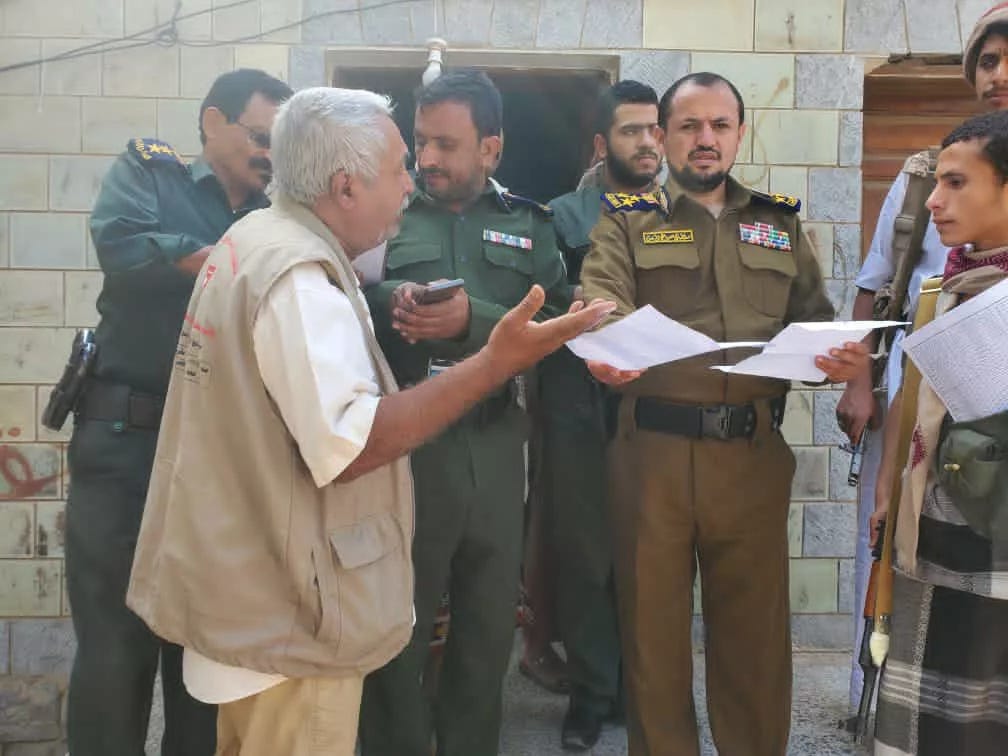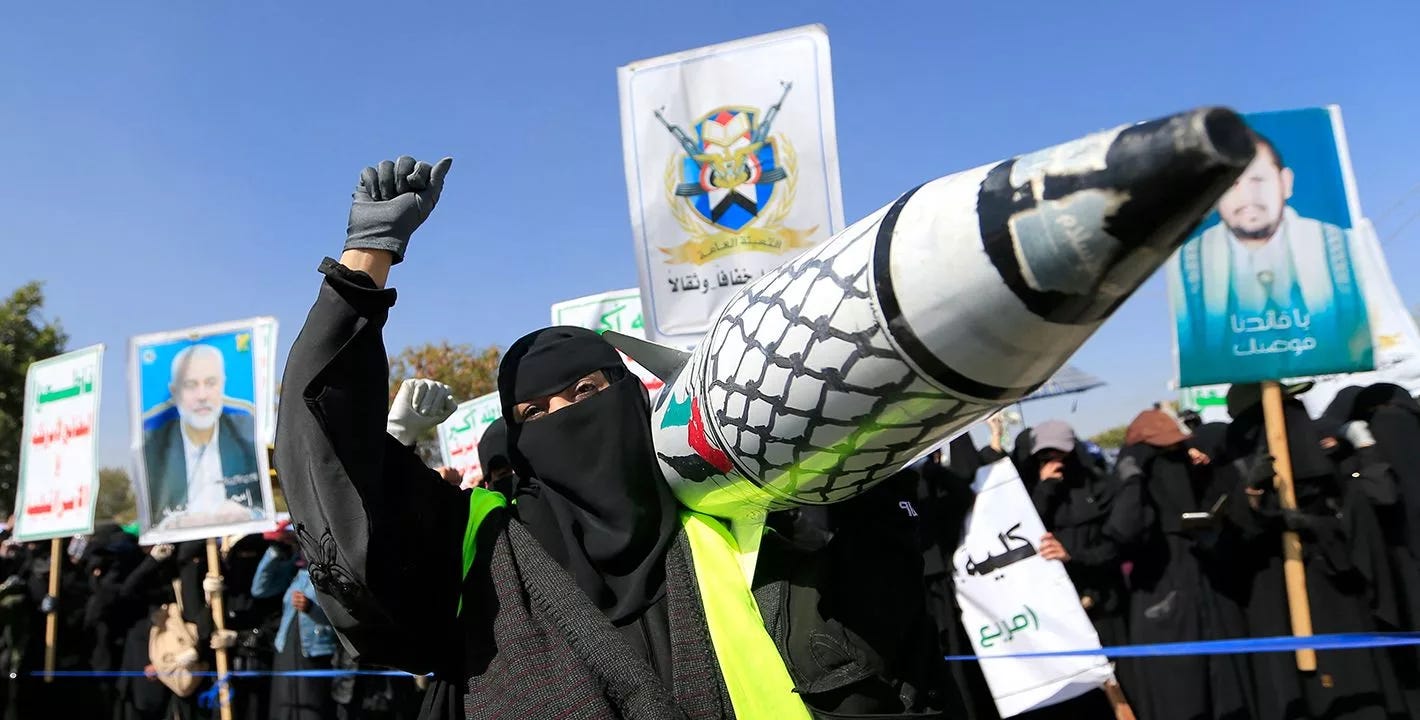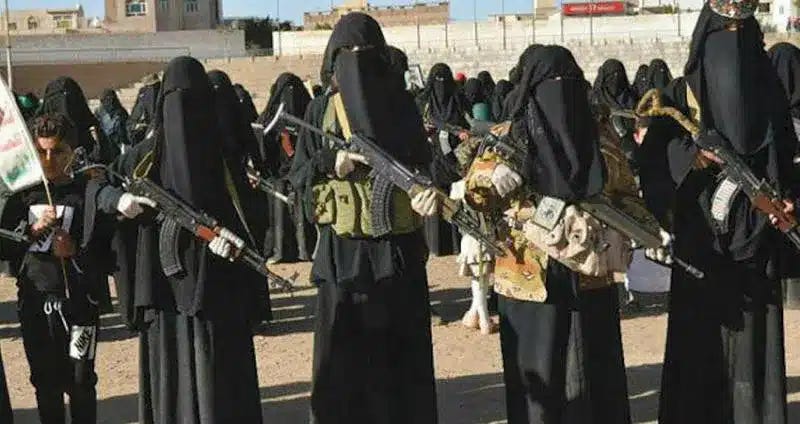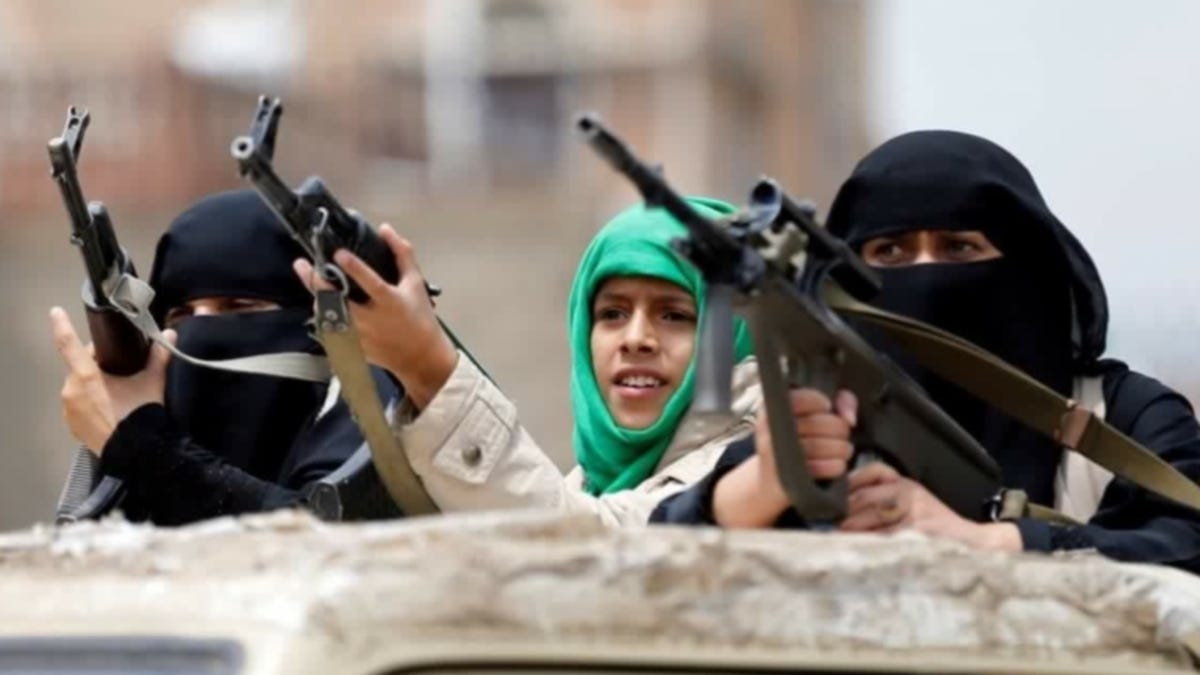Amid Yemen’s years of war and conflict, the Ansar Allah movement—known as the Houthis—has created sectarian security and military apparatuses against its opponents since its coup.
Among these, the all‑female military brigades called the “Zainabiyyat” stand out as one of the most dangerous covert entities the Houthis have deployed to repress women across this war-torn country.
In this report, we track one of the lesser‑known origin stories of this highly trained female military faction, trusted with carrying out raids and arrests. Operating beyond the law and outside state authority, it answers neither to the Interior Ministry nor to any legal oversight.
We ask: Who is behind this apparatus? Who comprises it, how is it structured, and how did it infiltrate Yemen’s social fabric? Where were its operatives trained, and who supervises them?
Origins of the Houthi Female Brigades
The seeds of the Houthi female brigades began over a decade ago in the movement’s main detention center in Saada governorate. The first signs emerged during the six devastating wars the Houthis waged against President Ali Abdullah Saleh’s government—starting in June 2004—and costing billions in budget losses and thousands of dead, injured, disabled, and displaced people.
But the first unofficial armed female formation emerged during the Houthi takeover of government institutions and the September 21, 2014, seizure of Sana’a, when the Houthis found it necessary to expand the Zainabiyyat’s role.
Since then, this covert female apparatus has escalated its extralegal security operations. Its leadership is nebulous and secretive, drawing from marginalized socio-economic groups—those muḥmašshīn, often of African descent, who suffer from poverty and racial discrimination.
Trained to raid, arrest female activists, disperse women-led protests, spy, entrap opponents and terrorize their families and property, they also monitor opinions and track women in private gatherings, wedding halls, and workplaces. They organize ideological sessions in social events.
The establishment of these brigades stems from the Houthis’ dire shortage of male fighters. The so-called “Women’s Committee” within the movement—reportedly overseen by one of Abdul-Malik al-Houthi’s sisters—recruits from schools, universities, poor families, vocational centers, and even prisons.
Through intimidation and sectarian incitement, the Houthis have recruited hundreds of girls in Sana’a and beyond. Widows and impoverished women have been drawn in due to lost incomes, forced to join this extremist apparatus.
Absolute loyalty to Houthi ideology is the primary criterion for selection. Leadership posts are passed through tribal or familial lineage, ensuring obedience to the group’s orders—even involving human rights abuses.
Evolution and Training
Initially tasked with intelligence and logistics—collecting information on opponents, supporting pro-Houthi gatherings, and spreading ideology among women—the Zainabiyyat gradually moved from surveillance to direct enforcement, arrests, and suppression.
The first combat-trained group, composed of wives, relatives, and close affiliates of senior Houthi leaders, was trained in Yemen under instructors from Iran, Lebanon, and Iraq. This mirrors Iran’s Basij women’s factions and ISIS’s Hisbah, earning the Zainabiyyat a reputation for extremist enforcement.
Their presence became public during a 2017 military parade in Sana’a. By 2020, they were officially militarized—receiving ranks like lieutenant, captain, and lieutenant-colonel—as they were deployed to frontlines with financial incentives.
Roles and Capabilities
Although their exact structure is obscure, estimates suggest thousands of them—over 5,000 women—trained in firearms, explosives, vehicle operations, and raids. Training sites range from schools and sports facilities to universities in Sana’a, with selected leaders trained abroad in Iran and Lebanon under IRGC protocols.
Their units, including Zainabiyyat brigades, the Women’s Authority group, Zahra brigades, and the Preventive Intelligence Division, execute raids, kidnappings, espionage, and frontline tasks, led by wives and relatives of Houthi leaders.
The “Preventive Espionage” wing poses the greatest threat to civil liberties—penetrating women’s gatherings, private homes, and protest spaces—leveraging access denied to male forces.
The most feared group is the “Amniyat,” affiliated with Houthi security forces reporting directly to the movement’s leader. They suppress women’s protests, raid homes, arrest female activists, and assault women in marches across Sana’a.
An “electronic brigade” disseminates propaganda, recruits online, spreads misinformation, and lures opponents into Houthi-held territory for arrest.
Zainabiyyat members often operate under pseudonyms on social media, pretending to represent various Yemeni factions while spreading rumors, defamation, and sectarian narratives, monitoring even WhatsApp discussions.
They also raid women’s mosques in Sana’a and imposed ideology at social gatherings, fully permeating different social strata.
Reports reveal abductions of young women in Sana’a, only to be released after sectarian re-education programs. Freed women are often coerced to recruit friends into training camps or fanatic circles linked to the Fatimiyyat recruitment network.
Controversial allegations also involve recruiting women and children via schools—instilling jihadist ideology from elementary age—under the directive of “Abu Ali al-Hakim,” Abdullah Yahya al-Hakim.

Some detainees accused of moral crimes were released only after cooperating, then used to target tribal leaders, businessmen, party figures, and others with threats and blackmail.
Yemen’s Human Rights Minister, Mohamed Askar, said the Zainabiyyat tracked and persecuted members of the General People’s Congress party and their families via illegal raids and arrests.
Their abuses extended beyond violence and intimidation: during a raid on December 2, 2017, on GPC leaders’ homes, they looted valuables, gold, and jewelry—and similar abuses continued as they coercively collected over $100,000 from women for the war effort.
After October 7, 2023, they pressured women in Sana'a, Ibb, and Hajja to attend pro-Palestine events and donate to support Houthi missile and drone forces.
A Dark Watchtower of Abuses
Since their origin as an intelligence arm, UN and rights groups have repeatedly documented the Zainabiyyat’s abuses—including sexual violence—against female students involved in protests or political activity.
This prompted the UN to form a sister group, the Fatimiyyat, to assume recruitment and indoctrination duties, allowing Zainabiyyat to remain focused on repression and combat.
A UN panel’s report identified Sultan Zabn (“Abu Saqr”), head of criminal investigation in Sana’a, as the direct overseer of these brigades. He was sanctioned in February 2021 for using female units for surveillance, espionage, and torture.
The panel documented arbitrary arrests, looting, sexual assault, beatings, torture, and facilitating rape in Sana’a’s secret detention centers.
Combat-trained Zainabiyyat—some carrying rocket launchers and rifles, including underage girls—have been recorded in operational roles.
One activist recounted being abducted, tortured, physically assaulted, sexually harassed, and threatened with rape to force a confession of cooperating with the Saudi-led coalition.
A November report by the Yemeni Network for Rights and Freedoms documented 1,444 violations from December 2017 to October 2022—ranging from abduction, arbitrary detention, looting, sexual assault, torture, rape facilitation, attacks on protesters in Houthi areas, and forced recruitment of school and university girls.
The UN continues to hold classified attachments exposing the Zainabiyyat’s war crimes and crimes against humanity, warning that their growing size and capability could eliminate civil freedoms in Houthi-controlled territories.





